|
|
|
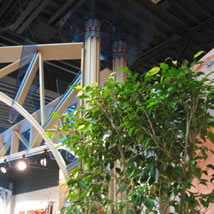 |
| The
basic concept of Armature as used here is based on
the
work of Herb Greene, Architect, as described in his
book Building to Last - Architecture As Ongoing
Art [rbtfBook]. Herb Greene made a great contribution to the theory of architecture by articulating his armature concept. Unfortunately, as far as I can tell, this concept has been largely ignored. Not only does it shine light onto issues of scale, it effectively addresses the role of history, the necessity for the preservation of architecture and points to the resolution of what is often thought of as conflicts between new and old works. Armature also directly address the necessity of artist and citizen involvement in the creation of public space. The lack of all this is a major cause of human alienation with the built environment particularly the city. |
| At tsmARCHITECTURE and AI, our use of the armature concept, while broad in scope, has been limited in scale only because our projects have been two to thirty thousand square feet thus far. As the size of our projects grows so will our exploration and practice of Armature. Hopefully, this will also be true more broadly throughout the profession. Herb Greene’s idea is needed now even more that in the past and I believe will be critical to the future execution of viable cityscapes. Visit his web site and enjoy an unique integration of architecture, philosophy and art: |
|
|
1981
Architectural Book Publishing Company
New York
|
|
|
Greene
dealt with the issue of uniformity and diversity
in
architecture on the scale of a cityscape. His basic
concept is that any viable city has an ARMATURE that
establishes a clear central, core, integrating
sense of what the city is as place. Herb
made a significant contribution to architecture
with this concept. The problem of scale is endemic to large cities as well as mea-structures. It is also a critical issue on the scale of large individual buildings. Rarely, is this scale issue dealt with effectively.
|
“Prevailing
economic and technological forces and aesthetic
attitudes have tended, in cities around the
world, to level the historic artifice, leaving
in its place new buildings with disorienting
and anonymous form. In these discussions I
want to offer a strategy whereby history and
place are again built into the city. I address
the question of how we can create new buildings
that not only enhance the sense of place bur
are likely to get better as they get older.
To conserve resources we need a process that
produces a building type that is solid and
long-lasting, yet responsive to additions,
alterations and ornamentation by individuals
over generations and that can become a record
of their aesthetic and social commentary.”
|
The
metaphor of an interior
as landscape [link] is
a solid and useful one. Almost anything that
can be said about a city can be scaled
and applied to a large interior. The issues that
Greene addresses on the city-scale exist within
the modern office building.
|
|
We
employ it on the level of cityscapes, buildings and
building interiors.
|
|
At
the scale of building interiors, the AI Armature
system consists of several components: The Tracery [link],
WorkWalls [link], Pod [link] [link],
CubeOffice [link]
and Artifacts [link].
These components, together, make it possible for
custom environments
to be crafted out of manufactured elements capable of making architectural-scale workspaces that are effective, economical and works of art. These unique and specific-to-each-user organization can be typically designed, manufactured and installed in 30 to 90 days. The system produces Favorable life-cycle economics: leasehold improvements are minimal, the system can move with the users, system components can easily and quickly be configured in different ways by the users and have an extremely long life, the resulting environment does not go out of style.
|
|
For
background and application of we have developed
and applied the
Armature concept to the work environment, the following
links will give you an overview:
|
AI
Design Session,
1998 [link]
1990
Concepts [link]
Environments
in Progress, 1999 - 2004 [link]
The
AI Cube Office System, 2000 [link] 20
years of Design, Build Use - a Story [link]
Vanderbilt
NavCenter, 2002 [link]
Joseki
Offices 2002,
[link]
Point
Arena Community
Center 2003 [link]
Salt
lake City VA NavCenter 2003 [link]
Master’s
Academy and College Collaboration
Studio 2004 [link]
WEF RDS Deployment 2005 [link]
UniCredit NavCenter 2006 [link] |
At
MG Taylor, we have applied and extended the concept of armature
to many areas of our work - both conceptual and physical.
In every process,
most significantly those processes designed to promote
emergence [link],
a strong armature is necessary to hold extreme diversity
in place. Armature and variety are reciprocal forces that must be kept in balance for systems to remain viable.
|
|
“I
have been most moved by architecture that shows the
efforts of many people bound together by common purpose
to create a transcendent aesthetic form. Contrary
to the mainstream in Modern Architecture, I have never
accepted the machine as a model for either functional
or aesthetic form but have continued to believe that
human spontaneity, cultural continuity and organic
connection to nature are primary sources in creating
architecture of the deepest and most lasting appeal.”
|
In
process, technology and environment the Armature
element
is what binds
[link] it
all together as an integrated experience.
|
“In
this book an armature is a public element in a neighborhood
or city core to which space-enclosing structures
and ornamental surfaces of individual determination
can be added or subtracted. It is solid and long
lasting. It is richly encrusted with the crafts
and arts of as many as thousands of participating
citizens. Since buildings constitute a principle
part of production and are a basic necessity, an
armature provides on-going work and an outlet for
the talents of citizens not now included in the
building process. The accretion of people’s
art and craft work and the modification of certain
spaces and forms designed by architects to accommodate
alterations, make the structure a vehicle of cultural
memory, a medium for expressing change and a metaphor
for the passage of time.”
|
|
When
considered on the scale of the workplace, this
viewpoint
reinforces why we believe the workplace should
be adaptable. Why it should be easily changed
by those using the space and why - including elements of
the architectural armature itself - the work [link] of
those using the space, and its “display” is
an important part of the environment and its trade-dress.
|
|
If
you want to think of armature in a city, think
of
San Francisco The hills, bridges, fog, parks, the
cable cars and bay all combine to create a strong
armature -
you know
you are in San Francisco no matter where you
stand. Inside this Armature, there exists remarkable diversity:
Victorians
next to modern buildings, working fishing marinas
next to upscale restaurants, modest apartments next
to luxury condos - it is a city of many contrasts with
a consistent and great Brand. San Francisco has
Trade Dress. Environments
on the scale of buildings, and their subordinate
landscapes, should capable of making the same signature.
|
|
Another
great example of Armature on the scale of a cityscape
is the Boulder
Mall [link] in
Boulder, Colorado. This Mall, as it has developed
over a 25 year period, defines the character
of the inner-city. The picture below was taken by me early in the morning on November 4, 2008 nearly 30 years after the restoration of Pearl Street was undertaken. The Mall will slowly come alive in the morning and become an active social space which will last late into the evening.
|
|
When
people are living and working in a space they
should
know where they are, there are in context - this
is not commonly the case today [link]. Armature, and the activities related to it, provides framework which establishes this context. The concept of armature
is perhaps one of the most important in architectural
language and was more commonly understood and employed in the past. This modern neglect
shows up in
the design of our cities, individual buildings and
down to the scale of interior landscapes. In a
broader
sense, not understanding armature negatively effects
organizational theory and the development of strategy.
Any endeavor that involves design can benefit from
the application of the Armature concept.
|
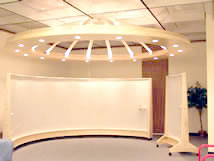 |
| A small Armature for the Department of Labor in Washington DC turns an otherwise generic space into a small collaborative workspace. The dome consecrates the working center and references the setting. |
|
In
the MG Taylor/AI work environments, the armature
elements
are the major architectural features. They are the “
post
and beam” elements and various objects like
domes,
platforms and major lighting elements by which we define space, carry
wires and other utilities and convey architectural themes. Armature brings richness to VERTICAL space [link] a
too often overlooked yet extremely important element for the making of human space.
Look at the dome and WorkWall system in the
illustration above. A SPACE is created with just these
three elements. This makes a place to work
that has focus and amenity. It invites participation and collaboration. It conveys intention. |
Master’s Collaboration Studio
September 2004 |
| The
Master’s Collaboration Studio [link] Armature
is one of our most sophisticated to date - it is a good
precursor of
where we are going. We are also working on projects
that will provide the opportunity to employ Armature
on a larger scale. The SDC [link] and
Master’s Campus [link] projects
and the SETI Visitor Center [link] each present possibilities
that will begin to get at the issues that Herb Greene
has so brilliantly articulated. |
| In recent years, the Armature concept - once unusual - has become a standard component of our interior work landscapes. They create unique place, carry wires, provide lighting, house multimedia technology, provide acoustic attenuation and provide a sheering layer between human scale and building scale. By altering Armature lighting, the sense of space can be compressed or expanded on both vertical and horizontal dimensions thereby making prospect and refuge “tunable” on demand. In recent projects, the Armature has been design to be re configurable as we have with our WorkFurniture for over two decades. In this way, a space can be easily configured to meet the physical and mental requirements of the users. |
| As of this writing, July 4th 2006, all of the Armatures shown below are in development - design and construction. Several other projects are on the drawing boards. Over the next couple of years, it is likely that the examples of Armature applications will double the totality of built works over the last 15 years. |
|
Armature elements are independent of the structural shell yet integrated with it and the many utility aspects of the building. Armatures reflect, and play counterpoint to, the building shell no matter how prosaic this may be as often is the case with commercial architecture.
Armatures are also significant carriers of theme [link: theme in architecture] and brand essence. They establish the most intimate look, touch and feel of a space. This transmits the message of the space its intention and appropriate use. This message acts to stimulate and instruct the users of the environment and can reduce significant barriers to creative work and productivity.
A sense of PLACE is a critical requirement for human happiness and productivity. This sense is composed of many elements: shelter, symbol, social context, way of working/living, usefulness and so on. Every work of architecture must mix these in different ways according to the buildings purpose and context. When done correctly, the architecture is like the background music in a movie. It “explains” what is going on. When done well, this context setting appropriately attenuates modes inappropriate to the task(s) and amplifies modes the space is designed to facilitate. Great clarity can be accomplished as architecture is built values.
Armature is also an opportunity for creative play - it is architectural galumphing. This play is actually serious and necessary to life which is greatly impoverished without it. This play - often called esthetics - contains embodied meaning. It is not random or arbitrary - it is purposeful. These drawings and photos are Armatures being conceived and installed. it is work in progress for the World Economic Forum, the The US Department of Veteran Affairs, Ales Groupe in Milan Italy, and Unicredit In Turin, Italy. |
|
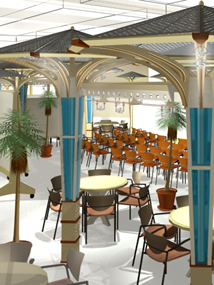 |
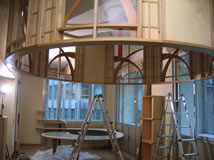 |
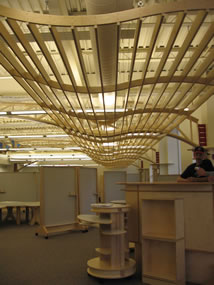 |
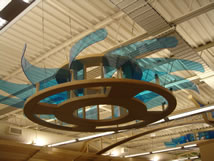 |
UniCredit Management navCenter design
September, 2006
|
Alse Groupe September 2006 |
UniCredit Management navCenter getting finishing touches
January 2007 |
| This page was started in 1999 and has been most recently updated nearly 9 years later. The masthead of this page includes a plan (upper right hand corner) completed by me in 1990. This was the first full expression on paper of the Armature concept as it can be applied to interior landscapes made up of manufactured components. By virtue of this system and method, routine, plain vanilla retail “boxes” can be transformed into architecture in a matter of 30 days with the vast majority of that which makes up the architecture readily movable to the next location. This breaks the tyranny of the commercial lease and its negative impact on the average cost working environment. It has taken over 15 years to make this demonstration. When this approach can be taken with a building of true architectural quality the results can be spectacular as is the case with the UniCredit bank project illustrated immediately above. The UniCredit project is the best example of Armature that we have executed so far because of its scope and scale and because it is part of an environment composed of three architectural traditions: 19th century Italian, modern glass and steel, and organic which is our contribution including the Armature which ties it all into one harmonious whole. This is a small example of what Herb Greene wanted to do on the scale of a cityscape. It is a demonstration of the viability of this idea. |
| In most cases, the examples of Armature illustrated here are remedial. In works of great architecture, as distinct from generic boxes, the Armature will be integrated into the structural system of the building. A great deal of the structure will be Armature. Also, it is important to remember that these examples are Armature on the recursion level of a buildings interior. Armature must exist on the street, community, city, regional, and eventually, global levels. Now that TSM Architecture is designing larger projects, examples of this scale of application will soon be posted thus carrying the idea further and much closer to Herb’s original insight and intent. |
|
| The armature concept is an important architectural principle as well as having application beyond this one art. The examples shown here just begin to scratch the surface of what can be achieved by adding this concept to the architect’s pattern language tool kit. As architecture becomes ever more ethereal - as seems to be the modern trend with the new materials - a strong armature that binds a work to the cityscape, the Earth and to a social context is increasingly important. Armature, in the end, becomes the strongest element speaking for the culture of a place. It makes Strong Memory. It brings idea and physical fact back together in a world where these are increasingly and unfortunately bifurcated. |
November 13, 2008 Update: |
| It has often been said that organic school architects are generally very nice people. I have found this to be true and Bruce Goff was an outstanding example of this tradition. Over the last year, I have had the pleasure of meeting Herb Greene and spending time with him in his home and studio in Berkeley. In an age when the concept has almost lost its meaning Herb is a gentleman of the first degree. He is an unique personality and original thinker. He is an important figure in the transitional period between the first masters of organic architecture and what one can hope is a resurgence of this approach to building habitat. As I have noted, his concept of Armature has been largely ignored yet there are signs that this will not long be the case. Without attribution and full understanding, the idea is beginning to find its way into built work. Seeing his drawings full size and talking to him further inspires my sense of urgency that his work should be more fully studied and applied. I have long respected him as an architect it is now my great pleasure to consider him a friend and companion in the cause of organic architecture. |
|
|
Matt
Taylor
Borgess navCenter, Kalamazoo
July 10, 1999
|

SolutionBox
voice of this document:
IDENTITY • PHILOSOPHY • CONTRACT DOCUMENTS
|
posted
July 10, 1999
revised
November 13, 2008
•
19990610.453766.mt • 19990916.232428.mt •
• 20010527.779981.mt • 20010724.662980.mt •
• 20020522.537190.mt
• 20030422.111100.mt •
• 20041002.987120.mt •
20041022.666611.mt •
• 20060704.321430.mt • 20080223.611091.mt •
• 20081113.451009 •
note:
this
document is about 90% finished
ArmatureSystem
is a Trademark of iterations and licensed to MG Taylor
Corporation.
Aspects
of the system and method described are Patented and
Patent
Pending. |
|
|